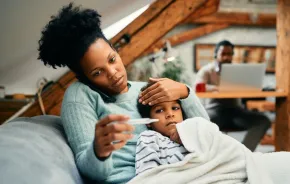
New parents, take note: the U.S. Food and Drug Administration has issued a consumer warning about using infant sleep positioners. You’ve probably seen these products in stores or online, marketed as “nests” or “anti-roll” products for infants under the age of 6 months. They sound safe, but the FDA says otherwise.
There are two common types of sleep positioners: a foam wedge used to elevate a baby’s head or a flat mat that features raised bolsters attached to each side. These positioners are meant to hold the baby in position to prevent rolling while sleeping.
I used the bolster-type positioner when my oldest son was an infant, relieved to have something that would keep him from rolling from his back to his stomach. The soft bolsters on the sides seemed to soothe him and help him sleep, which was also a huge relief to this tired mama. But the FDA says these products should not be used as they can cause suffocation that can lead to death. Yikes!
Reports of babies who have died from suffocation or become injured or dislodged in infant sleep positioners is what is driving the latest recommendation, but the FDA has been issuing warnings about positioners since 2010 when they asked manufacturers to stop marketing them. Prior to that, some sleep positioning products had been approved by the FDA to be used for babies experiencing Gastroesophageal Reflux Disease (GERD), in which stomach acids back up into the esophagus, or plagiocephaly (flat head syndrome), a deformation caused by pressure on one part of the skull.
But new information in 2010 regarding the risk of suffocation led the agency to require manufacturers of FDA-cleared sleep positioners to present data showing that the benefit of the products outweighed the potential risks.
According to the American Academy of Pediatrics, around 3500 infants die each year in the United States from sleep-related deaths, including accidental suffocation and Sudden Infant Death Syndrome (SIDS). The FDA makes it very clear on their website that sleep positioners claiming to prevent or reduce the risk of SIDS have never been cleared for use, as there is currently no scientifically supported evidence to back any such medical claims.
A simple guide for parents to follow is to remember the ABCs of safe sleep: “Alone on the Back in a bare Crib.” The AAP recommends that infants should be placed on their backs on a firm surface such as a crib or bassinet with a fitted sheet with no soft bedding or toys nearby. They also recommend having baby sleep in the bedroom (but not on the same sleeping surface) with parents, as room sharing can reduce risk of SIDS by as much as 50 percent.
So toss the infant sleep positioner and talk to your pediatrician if you have any concerns about how to help your baby sleep better.











